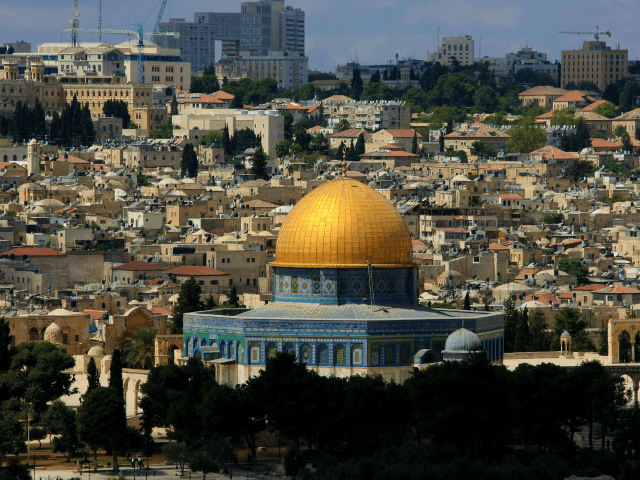In recent Congressional hearings on the question of transferring the U.S. embassy in Israel from Tel Aviv to Israel’s capital, Jerusalem, some, such as former U.S. ambassador to Israel under the Obama Administration, Dan Shapiro, have argued that dividing Jerusalem between Israel and the Palestinian Arabs in the context of a peace agreement would provide the opportunity to do so.
This advice is best not heeded. Moving the embassy has merits that need not await an Israeli/Palestinian Arab peace, while the idea of dividing Jerusalem is far from the unproblematic transaction Ambassador Shapiro imagines.
Those who speak blithely of re-dividing Jerusalem assume that tensions will be thereby eased; that Palestinians will live peacefully under their own administration while Jews live peacefully under theirs; that security cooperation between the two sides can offset whatever dangers arise, and so on.
The opposite is true: re-dividing Jerusalem threatens Israel’s entire strategic security architecture and thereby would imperil the peace and Israel’s very existence.
As Major-General Gershon Hachoen and Ephraim Inbar have indicated in a recent study, removing Israeli control from the eastern half of Jerusalem and thus yielding to the Palestinian Authority (P.A.) a position on the commanding heights of the Jerusalem hills would deprive Israel of the vital strategic depth that it current enjoys.
Strategic depth, defined as surplus territory at the front line that does not impinge on the vital territory and thus the functioning of the country, would be imperiled by a divided Jerusalem.
The 1949 armistice lines, which involved Jordan controlling the mountainous ridge and Jordan Valley, meant that Israel lacked strategic depth. It was chiefly this fact that necessitated an Israeli pre-emptive strike in the 1967 Six Day War. Israel could not wait and risk combating an Arab offensive on the lines which they then held, with their backs to the sea.
It was for this reason that the late Israeli statesman Abba Eban refereed to the 1949 armistice lines as the “Auschwitz lines.”
The problem is that a good deal of this earlier peril would be reproduced not only by a return to the 1949 armistice lines but also by ceding eastern Jerusalem to P.A. control.
A return of hostile forces to the Jerusalem and Samaria mountain ridge overlooking Israel’s coastal strip would result in Israel’s major national infrastructures –– Ben Gurion Airport, the ports of Haifa and Ashdod, military installations, computerized data bases, electrical power and desalination plants, and so on –– as well as the concentrated bulk of the Israeli population (60%) being close proximity to enemy forces positioned in the dominating Jerusalem heights overlooking the narrow Israeli coastal strip
Thus, even if the Jordan River remained the security border, with the exception of eastern Jerusalem given to P.A. control, Israel would still face the problems of the absence of strategic depth it would face if it returned to the 1949 armistice lines.
Such a P.A. foothold would enable terrorists a commanding position for rocket, missile, artillery and sniper fire into the coastal strip between Hadera and Rehovot, a coastal strip that, at certain points, is a mere 9 miles wide. Ben Gurion Airport, Ashdod Port, power stations, and military installations and assembly points for mobilization in the event of war are entirely visible and well within range of terrorist forces occupying positions in the eastern half of Jerusalem.
Moreover, the corridor from Jerusalem to Maale Adumim, and from there to the Jordan Valley, is strategically vital, enabling deployment of massed forces due to the absence of a dense urban concentration. With the eastern half of Jerusalem ceded to P.A. control, Israel would be deprived of this vital area and the rapid and effective mobilization of forces in the Jerusalem area it enables.
If Jerusalem was to be re-divided, it would become impossible for Israel to defend the urban seam lines within the city, because the Israel Defense Forces would have to cross back and forth across what would be P.A. controlled territory.
Jerusalem, due to its position and topography, is the juncture between north and south and east and west in the country. Ceding a foothold there to potentially hostile forces could enable a well-planned enemy assault to divide the country and disrupt communications.
There is also the ramifications for Israel intelligence-gathering involved in any move to cede Israeli authority in the eastern half of Jerusalem. Due to its location and altitude, intelligence-gathering outposts in eastern Jerusalem provide vital intelligence of developments in P.A. areas to the east, north, and south of the city.
Additionally, if eastern Jerusalem was handed over to the PA, vast amounts of Israeli manpower would be required to ensure that the consequent security fence put in place would prove effective. Such a fence, while undoubtedly necessary, also works to protect the P.A. from Israeli operations, providing a haven for enemy forces, much like the security fence surrounding Gaza.
Dividing Jerusalem is an invitation to enemy sniping attacks from close quarters from the eastern half of the city, as indeed was the case before 1967. No one had devised a credible plan for avoiding these dangers and pitfalls. Israel dare not reproduce the conditions of insecurity and danger that prevailed then. An intact and undivided Jerusalem is the only way to guard against such a scenario.
Morton Klein is president of the Zionist Organization of America. (Visit www.zoa.org) A major Jewish weekly named him one of the top five Jewish leaders in America. Another named him one of the top dozen “Jewish activists of the Century.” He also worked in medical research as a biostatistician with two time Nobel laureate Linus Pauling.

COMMENTS
Please let us know if you're having issues with commenting.